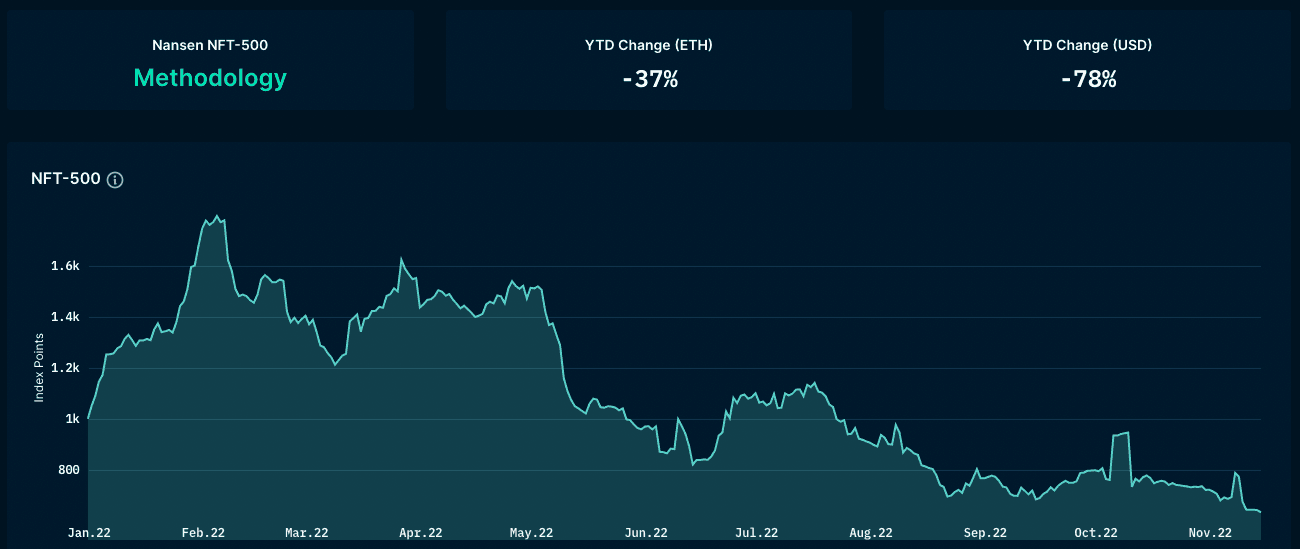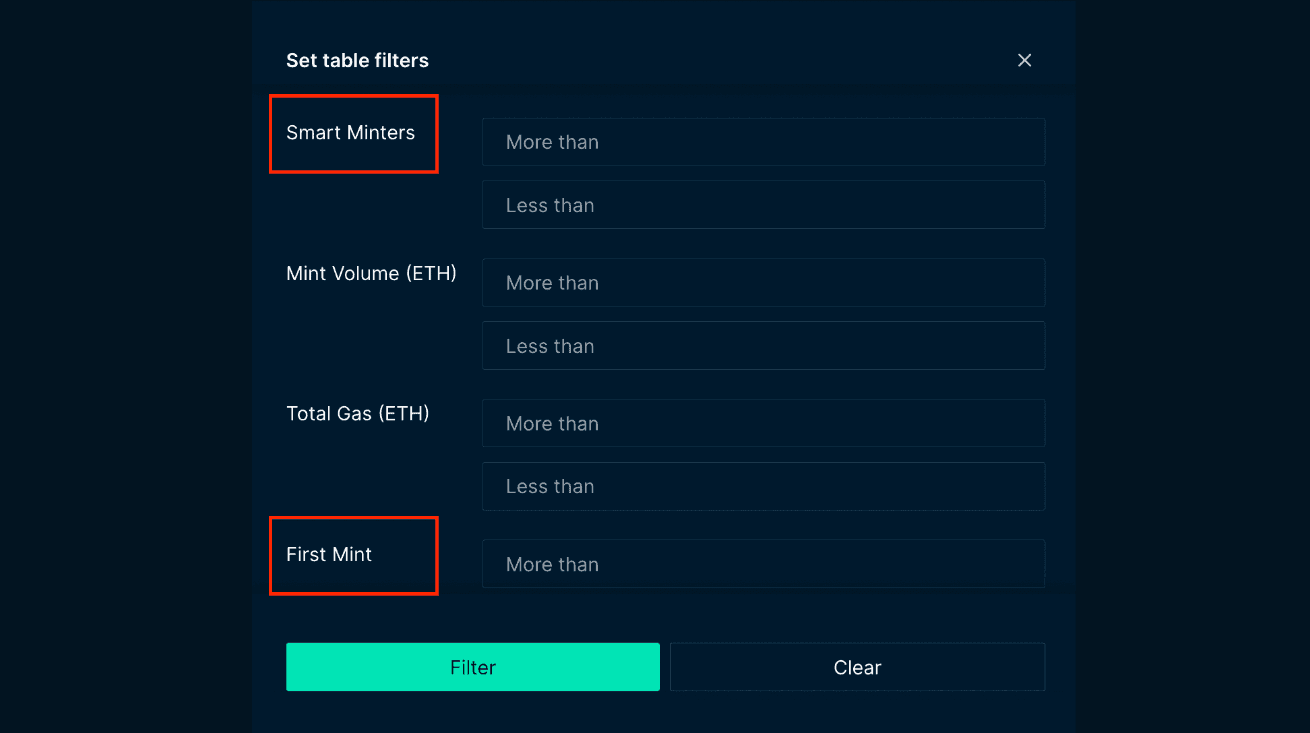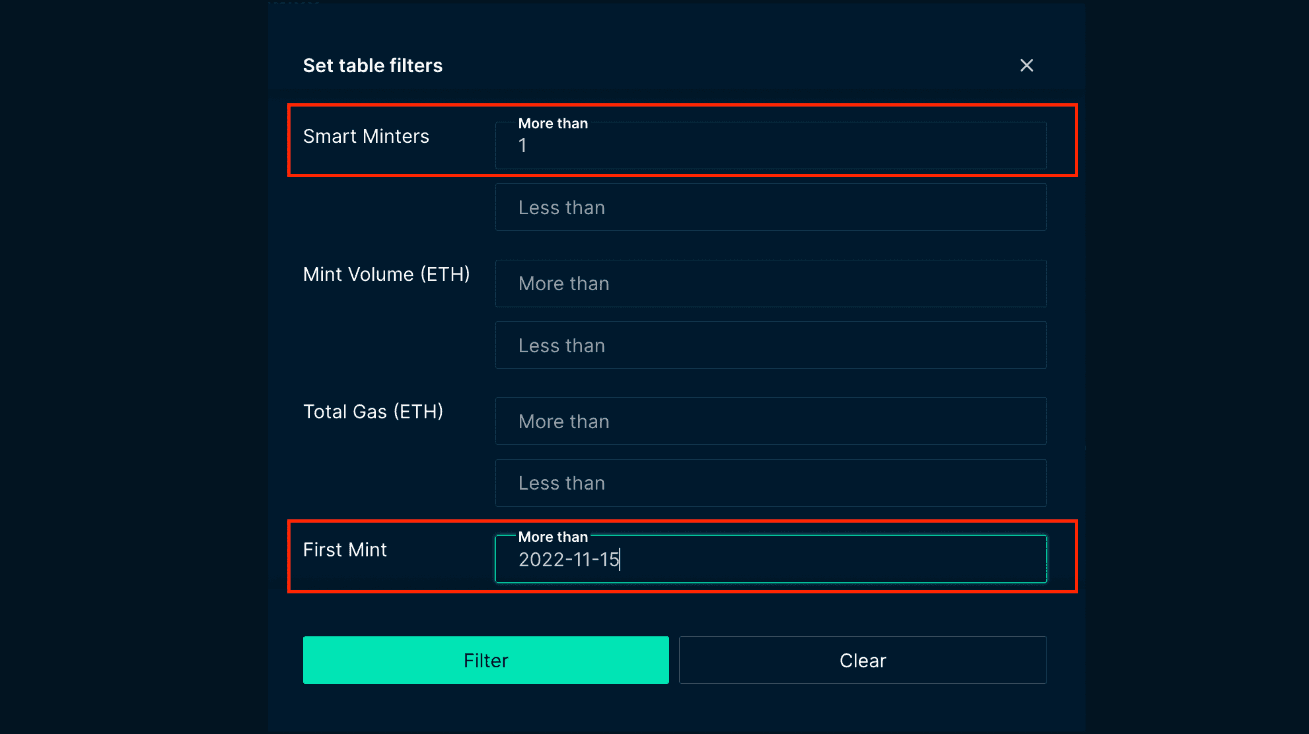Introduction
The NFT market has been in a downturn since the end of May, with significantly lower transaction volume and user activity. According to Nansen Trends & Indexes dashboard, the overall market in NFT sales has plummeted since June 2022. Volume measured in ETH for NFT sales reached an all time low in September and has paled in comparison to earlier parts of 2022. The NFT-500 index also presents a bearish NFT market environment as the index points continue to drop and is now down 37% YTD measured in ETH and 78% YTD measured in USD.
As the NFT sector has shifted from a bull market to a bear market, many indicators that Nansen users had previously used to evaluate NFT collections may no longer be valid. For example, the 7D inflow for Hot NFT Contracts back in February could easily surpass $1m but now only the top contracts reach $100k inflow (Source: Hot NFT Contracts). Similarly, many Hot NFT collections used to accumulate more than 5 Smart Money Depositors whereas now it is rare to see a single NFT collection to reach this amount.
Purpose
This benchmark indicator analysis is important because this change in market conditions creates a challenge for Nansen users to gauge and evaluate NFT collections. Once a benchmark for NFT collections is standardized, Nansen users can easily navigate through all the projects that pass those benchmarks to filter down the watch list and allocate into those projects that are very likely to make profits.
Nowadays, many NFT projects are already highly valuable in the secondary market. For example, the floor price for Bored Ape Yacht Club NFT on OpenSea as of today is 57.9 ETH, equivalent to $73,230.76. Even if there is huge potential for upward price action in this NFT collection, it is quite difficult for a general NFT individual investor to ape into without sufficient funds.
Instead, this report will focus on the primary market by creating a benchmark indicator based on all recently minted NFTs. The cost of entry (low mint price + gas fees) in the primary NFT market is more price friendly to normal individual investors compared to the cost of flipping (high floor price + gas fees) those highly valuable projects in the secondary NFT market with a significant amount of Smart Depositors. Thus, the analysis concentrates on benchmarking Smart Minters as an indicator to anchor profitability based on historical performance over the last 120 days.
Methodology
According to Nansen Query on NFT Paradise, only 44 NFT projects were minted by Smart Minters in the last 24 hours as of November 15, 2022. In order to have sufficient sample size to conduct a data driven benchmark analysis, the date range is expanded to last 120 days or 4 months. After the adjustment, there were 2,644 NFT projects minted by Smart Minters. The main reason behind why 120 days is chosen is because the past 4 months have a similar market condition. As mentioned in the introduction, the bear market started about 4 months ago in the beginning of June with a significant decrease in sales volume and users per week as seen in Nansen Trends and Indexes.
In order to develop a benchmark indication on profitability for Smart Minters, an estimated profitability percentage is calculated for each of the 2,644 NFT collections using the following steps.
For each of the 2,644 NFT collections:
- Identified first mint date, volume, total NFTs minted, floor price 1/7/14/30D after mint
- The 1D to 30D time frame gives the market sufficient time to develop a floor price for a newly minted NFT while not too long enough for the floor price to plummet.
- Divided volume by total NFTs minted to calculate average mint price
- Divided average mint price by floor price 1/7/14/30D after mint to estimate profitability
- Filtered NFT Collections by:
- average mint price >= 0.05 (free mints or low mint price NFT are excluded to not bias the benchmark results due to low entry cost)
- NFTs minted > 200 (NFT collections with less than 200 NFTs minted are excluded because it’s unlikely that investors could mint)
- After the filter, segmented the remaining 291 NFT collections into 4 categories and compared their estimated profit (%)
- <10 Smart Minters
- 10-19 Smart Minters
- 20-29 Smart Minters
- 30+ Smart Minters
NFT Specific Smart Money Minters Benchmark

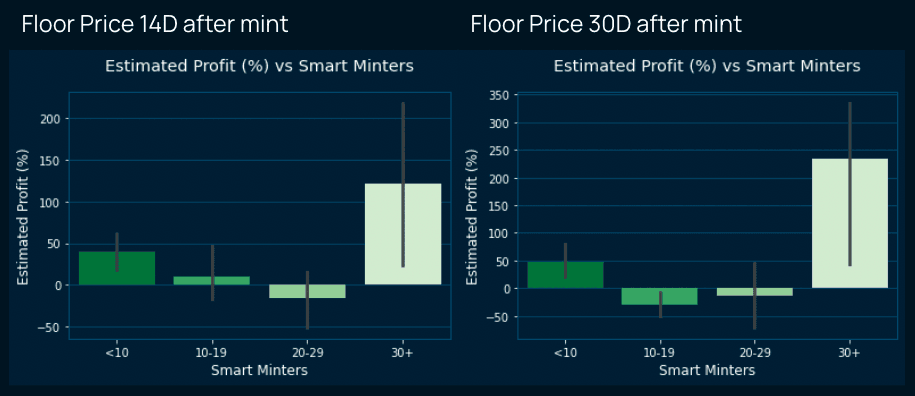
The benchmark analysis consists of four bar chart diagrams comparing estimated profits in % against the number of smart money minters. Each bar represents a specific range in terms of the quantity of smart money minters, ranging from “<10”, “10-19”, “20-29”, to “30+”. The height of the bar represents the average estimated profits for the NFT projects falling within each specific quantity category.
Long-term Flippers Key Findings (30+ days post-mint)
The main takeaway from the analysis is that if projects were to accumulate “30+” smart money minters they can provide outstanding profit return. This is especially true for long term investors flipping projects minted 30 days prior, with an estimated historical profit of 230% on average. However, investors should also be aware that the estimated profit drops significantly for NFT projects that fail to reach “30+” smart money minters. The estimated profit for “<10”, “10-19” and “20-29” smart money minters projects is minimal and can be negative.
Short-Term Flippers Key Findings (1-7 days post-mint)
For quick flippers that try to make a profit in 1 day or 7 days after mint, the projects who accumulate at least 1 smart money minter have historically provided a positive return on average. One caveat is that all the above trends and patterns do not always hold true because of the variance that exists, which is why these findings stand as a benchmark and not as a source of truth for traders looking to profit off of mints. Hence, the benchmarks should serve as a complimentary baseline for investors to consider when investing in the primary NFT market (alongside their own internal benchmarks such as volumes, social media, etc.).
The NFT-specific smart money minters benchmark results can be summarized as follows:
| Days After Mint | Smart Money Minters Benchmark | Average Estimated Profitability |
|---|---|---|
| 1 | 1+ | 125% |
| 7 | 1+ | 60% |
| 14 | 30+ | 125% |
| 30 | 30+ | 230% |
Source: Nansen Query (as of November 15, 2022)
All Smart Money Minters Benchmark
To complete the analysis, analysis was extended to all types of smart money minters, incorporating investors labeled as “Smarter LP”, “Smart LP”, “First Mover Staking”, “Private Sale Investor”, “Flash Boy”, “Smart Dex Trader”, “Fist Mover LP”, “Airdrop Pro”, “and Fund”.
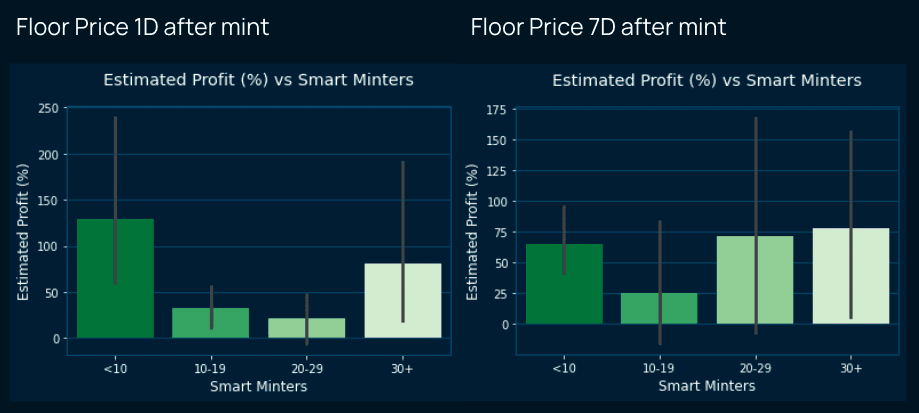
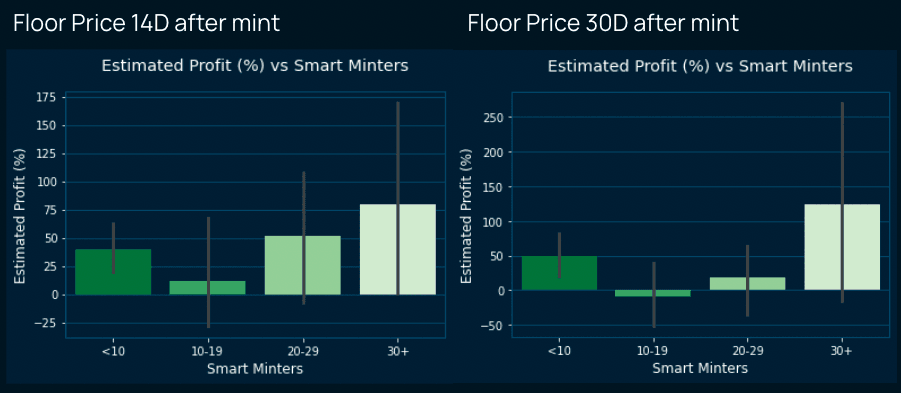
Compared to the benchmark from only NFT-specific smart money minters, the benchmark slightly varies for a more comprehensive group of smart money minters. On average, all projects with at least 1 smart money minter offer a positive return up until 14 days following the NFT mint date. This suggests that projects with smart money minters in general indicate profitability. While the quantity of smart money minters needed to confirm profitability grew exponentially for long-term investors. This is understandable since as time goes on, the market stabilizes and offers less opportunities for speculation, meaning that only projects of exceptional quality will stand out. This concept aligns with the findings on NFT-specific smart money minters.
The smart money minters benchmark results can be summarized as follows:
| Days After Mint | Smart Money Minters Benchmark | Average Estimated Profitability |
|---|---|---|
| 1 | 1+ | 125% |
| 7 | 1+ | 65% |
| 14 | 1+ | 40% |
| 30 | 30+ | 125% |
Source: Nansen Query (as of November 15, 2022)
Takeaways
Given the smart minters benchmark developed for different post-mint days, what is the best way to make use of the analysis?
- Using Latest Mints dashboard to filter for NFT projects that have a high likelihood of Profitability:
The Latest Mint dashboard on NFT Paradise Mint Master displays the latest NFT projects sorted by fomo (fear of missing out) and by default include projects minted in the last 14 days.
To filter down the list of projects to look at, Nansen users can simply click the top right hand corner of the dashboard interface to bring the filter pane up. In addition, the dashboard can be sorted by the “Smart Minters” and “First Mint” column simply by clicking on the text. The filter pane looks like this:
- For example, if the “First Mint” column is filtered to be more than ‘2022-11-15’ and “Smart Minters” column to be More than 1 as followed:
- After the resulting table is sorted by the “Smart Minters” column, there are 12 projects in total that were minted within the last 24 hours and have accumulated at least 1 smart minter, such as Sweeties (63 smart minters), RektWTF (26 smart minters) and so on.
- As seen in the above demonstrations, these parameters are easily adjustable to find more interesting projects! However, users need to be aware of the existence of spam NFT projects and always conduct due diligence before investing into any NFT projects!
Conclusion
Key Terms
| Term | Definition |
|---|---|
| Smart NFT Trader | The top 100 addresses in terms of realized profits from NFT sales and top 100 addresses based on our internal trader score metric |
| Smart NFT Hodler | The top 100 addresses in terms of estimated profits of their current NFT portfolio and top 100 addresses based on our internal hodler score metric |
| Smart NFT Early Adopter | The top 100 addresses that have invested in selected blue-chip projects before a specified date and are still holding an NFT from the project |
| Smart NFT Minter | The top 100 addresses that have at least ≥ 5x realized profits on multiple collections that were minted in the last 60 days |
| Smart NFT Sweeper | Addresses that have profitably swept (bought a certain no. of tokens from a collection in a single day, for at least a threshold ETH value) at least 3 different NFT collections, for a minimum of 5 sweepings |
| Smart NFT Airdrop Pro | Addresses that have received a significant amount of NFTs across multiple airdrops (Airdrops are valued based on the 7d average after the distribution starts) |



